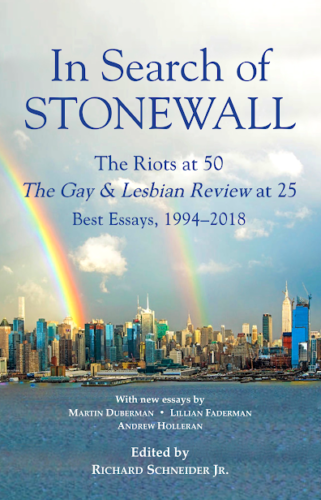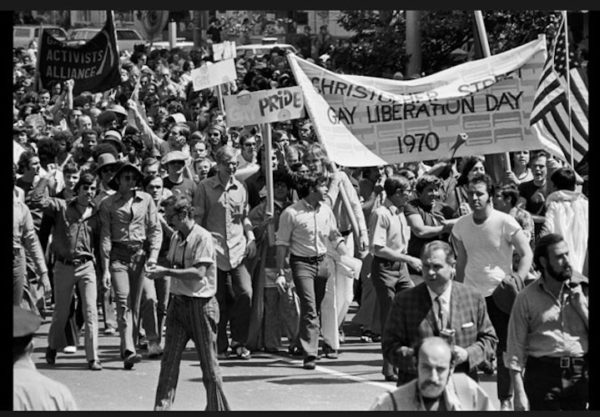Book Review: “In Search of Stonewall” — Illuminating Queer History
By Sophie Lellman
The essays here give readers an eyewitness glimpse into mid-century queer life will intrigue (if not shock) younger LGBT+ people.
In Search of Stonewall: The Riots at 50: The Gay and Lesbian Review at 25: Best Essays 1994-2018 edited by Richard Schneider Jr. G&LR Books, 225 pages, $19.95.
 “To me, she was the Rosa Parks of the LGBT movement,” declares Victoria Cruz in the 2017 Netflix documentary The Death and Life of Marsha P. Johnson. “She was an icon of the gay movement,” agrees Sylvia Rivera, a noted trans activist. “Marsha was known through the world.” So why does The Gay and Lesbian Review’s new collection of essays Searching for Stonewall fail to mention Marsha or any of the other trans women of color who were key figures at Stonewall and in the Gay Liberation Movement?
“To me, she was the Rosa Parks of the LGBT movement,” declares Victoria Cruz in the 2017 Netflix documentary The Death and Life of Marsha P. Johnson. “She was an icon of the gay movement,” agrees Sylvia Rivera, a noted trans activist. “Marsha was known through the world.” So why does The Gay and Lesbian Review’s new collection of essays Searching for Stonewall fail to mention Marsha or any of the other trans women of color who were key figures at Stonewall and in the Gay Liberation Movement?
“The vast majority of those who directly participated in the rioting, or observed it from the sidelines, have never been asked for or offered their versions of what took place,” notes Martin Duberman in the introduction to Part I. “Among the small minority who have borne public witness, accounts vary — sometimes crucially.” This collection leaves out many voices, but many of the contributors are keenly aware that the contentious question of “what took place on that June night, and above all who participated, has never been settled to everyone’s satisfaction,” as the book’s editor Richard Schneider Jr., founder of The Gay and Lesbian Review, notes in the preface. “Most of the attention has centered on the demographic question of who was present at the Inn — what was the ethnic mix, the ratio of drag queens to working-class youths, etc. — and who threw the first punch or the first brick.” Opinions on these matters differ widely. “The street people and the drag queens were the vanguard of the movement,” claims Sylvia Rivera in The Death and Life of Marsha P. Johnson, while Michael Denneny decries “the revisionist attempts by the currently politically correct to downplay the role of white males in that event.”
Yes, the predominance of white, cisgender male voices does somewhat diminish the value of this collection. But the essays that give an eyewitness glimpse into mid-century queer life will intrigue (if not shock) younger LGBT+ people. In particular, the essay by Del Martin and Phyllis Lyon, who founded the lesbian group Daughters of Bilitis in 1955, vividly articulate the isolation and fear that characterized lesbian and gay existence in the pre-Stonewall era: “There was no sense of community as exists today,” they recall. “Lesbians were isolated and separated — and scared.” Indeed, as Harry Hay asserts in his essay “Birth of a Consciousness,” “we [first members of the gay organization the Mattachine Society] knew we were not the degraded, degenerate monsters that society’s laws and religious prejudices made us out to be. But we also knew that we didn’t yet have the concepts, let alone the words, to say so.” That consciousness came later.

Marchers entering Central Park at the first Pride parade in New York City, June 28, 1970.
The idea that being LGBT+ is an identity and a community, not just a set of behaviors, is often taken for granted by youth today. This collection provides an eye-opening look into the formation of LGBT identity and community that began with the creation of groups like Martin and Lyon’s Daughters of Bilitis and Hay’s Mattachine Society. The voices in this collection will also help readers reconnect with, in Schneider’s words, “the overpowering energy and excitement of this period.” In his introduction to Part 3 of the book, bestselling author Andrew Holleran reflects on the radical zeitgeist of the period, exploring how the urgency and idealism of that period has given way to assimilation politics.
Many of the essays in this collection also contribute to an understanding of the movements that shaped and inspired the Gay Liberation movement. Will Roscoe locates its emergence out of communist organizing practices and as a reaction to McCarthyism. John D’Emilio and Eve Goldberg cite the growing radicalism of anti-war and civil rights activism for the emergence of Gay Liberation activism. Still others trace the Gay Liberation movement’s roots back to the early feminist movement. Together, these essays give a nuanced look into the foundations of the Gay Liberation Movement.
This book’s chief success lies in how it contextualizes the events of Stonewall and evokes the spirit and energy of the early Gay Liberation movement. As a document that chronicles the emergence of LGBT+ community in America, Searching for Stonewall provides a greater understanding of a pivotal period of queer people’s history in all its complexity.
Sophie Lellman graduated from Macalester College with a BA in Linguistics. She is currently working on literary translation from Portuguese
